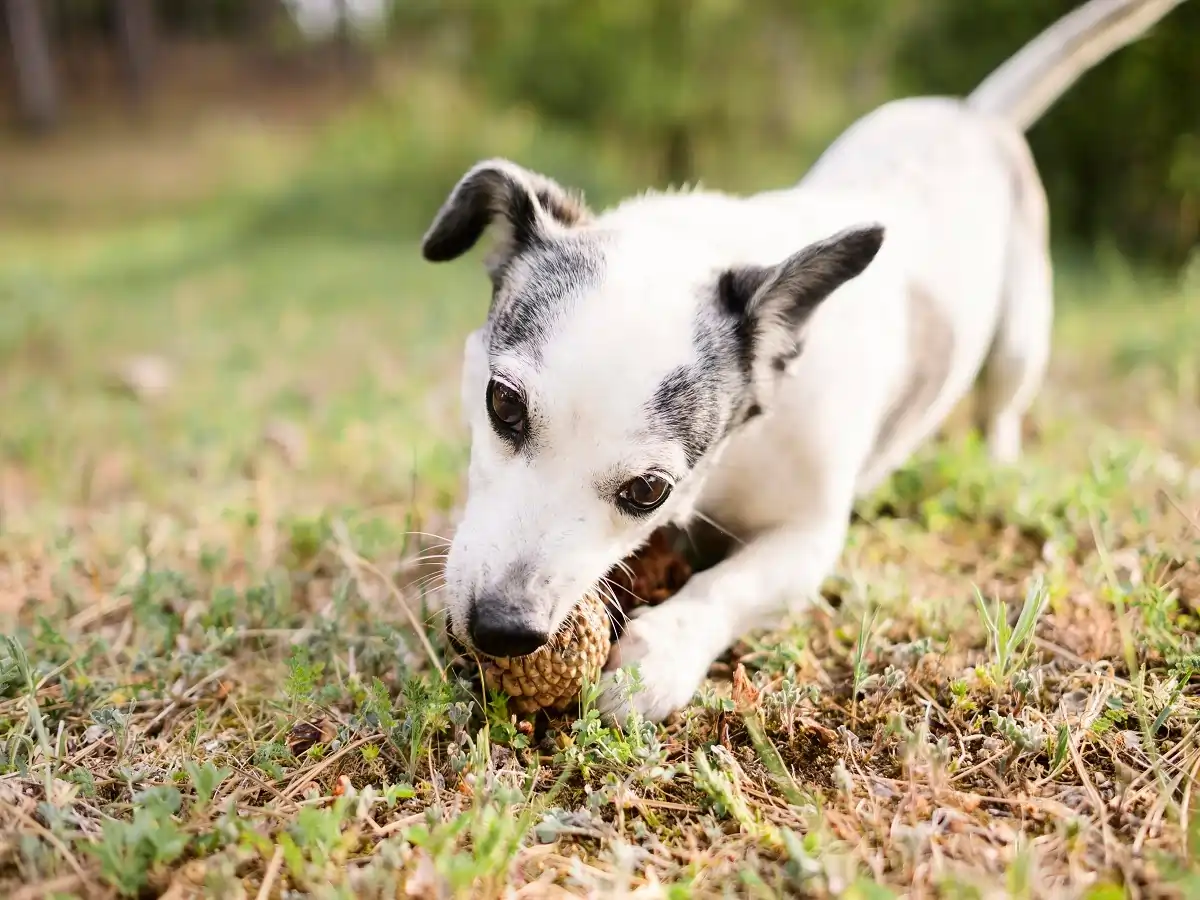It is important for pet owners to understand why their dog is dry heaving. Sometimes it is not a big deal, but other times it could mean something serious. If your dog dry heaves occasionally, it might not be a problem. But if it happens a lot or is really bad, it could mean your dog has a health issue that needs attention right away.
In this blog we will help you to figure out what is going on. We will talk about why dogs dry heave, from small issues to big health problems. Knowing this stuff can help you take care of your furry friend better. We will cover signs to watch for and when to get help from a vet. Let’s dive into the details of dry heaving in dogs and how you can help your pet stay healthy.
Table of Contents
ToggleWhat is Dry Heaving in Dogs?
Dry heaving in dogs, also called retching, happens when they try to throw up but nothing comes out. Unlike regular vomiting, where stuff comes out of their stomach. Dry heaving is just the stomach muscles squeezing without anything coming out. This can be worrying for both dogs and their owners because it usually means there is something bothering their tummy or throat.
Symptoms of Dry Heaving in Dogs:
Symptoms of dry heaving in dogs may include:
- Repetitive Retching: Your dog may exhibit frequent, repetitive retching motions without producing any vomit.
- Gagging Sounds: Audible gagging or choking sounds may accompany the retching.
- Abdominal Contractions: You may observe your dog’s abdomen contracting forcefully during the retching episodes.
- Lethargy: In some cases, dogs may appear lethargic or weak, especially if the dry heaving is accompanied by other symptoms.
- Loss of Appetite: Dogs experiencing discomfort from dry heaving may lose interest in food or treats.
- Restlessness: Your dog may display signs of restlessness or discomfort, such as pacing or inability to settle.
Difference Between Dry Heaving and Vomiting
When your dog is sick, it might do two things, vomit or dry heave.
- When a dog vomits, stuff comes out of its stomach, like food or bile. This makes the dog’s belly squeeze, and there is spit and fluids too.
- But with dry heaving, the belly still squeezes, but nothing comes out of the stomach. Even though the dog tries hard, nothing gets thrown up.
It is important to know this difference so you can understand if your dog needs help from the vet.
5 Common Causes of Dry Heaving in Dogs
When dogs dry heave, it could be from different things making them feel uncomfortable. Knowing these reasons helps figure out how to help your dog. Here are some common reasons why dogs dry heave.
1. Foreign Object
If your dog swallows something it should not, it can cause a lot of problems. Signs that your dog might have something stuck in its throat include drooling a lot, making choking sounds, struggling to swallow, pawing at its mouth, and seeming distressed. Dogs can swallow all sorts of things by accident or out of curiosity, like small toys, bones, sticks, cloth, or fabric. When these things get stuck in their throat or belly, it can hurt and block things, making it hard for them to breathe or swallow.
In serious cases, they might even dry heave as their body tries to get rid of the thing stuck inside them. If you think your dog swallowed something it should not have. It is important to get help from the vet right away. They can remove the object and make sure your pet is okay.
2. Gastric Dilatation-Volvulus (GDV)
Gastric Dilatation-Volvulus, or GDV, is a serious problem for dogs. It happens when the stomach fills up with gas and twists, trapping food and gas inside. This twisting stops the normal flow of things in the stomach, making it swell quickly and cutting off blood flow to important organs. GDV is very dangerous and needs quick treatment because it can cause serious issues like tissue death, shock, and harm to organs. Dogs with GDV might show signs like a swollen belly, trying to throw up without anything coming out, feeling restless, having trouble breathing, pale gums, and a fast heartbeat. When dogs with GDV dry heave, it is because their stomachs are twisted. So, they can’t throw up properly.
Getting help from the vet right away is really important for GDV because it can get worse fast and become life-threatening in just a few hours. Treatment usually involves fixing the stomach twist with surgery and helping the dog feel better. Recognizing how serious GDV is and acting quickly to get help can save a dog’s life.
3. Kennel Cough
Kennel cough, also called canine infectious tracheobronchitis, is a contagious cough dogs can get. It is caused by viruses and bacteria. Dogs with kennel cough have a dry, hacking cough, especially when they are excited or exercising. This can make them feel tired and worn out. Sometimes, the coughing can make them retch or gag, but nothing comes out. Kennel cough usually goes away on its own in a few weeks, but resting, using a humidifier, and giving cough medicine can help ease the symptoms.
If the coughing keeps going or gets worse, or if there are signs of other problems like pneumonia. It is important to see the vet. Knowing the signs and treatment options for kennel cough helps give dogs the right care and stops it from spreading to other dogs.
4. Respiratory Infections
Respiratory infections in dogs can make them sick in different ways. There are illnesses that affect their upper and lower breathing tubes, like bronchitis and pneumonia. Bronchitis makes the breathing tubes inflamed, causing coughing and trouble breathing. Pneumonia makes the lungs inflamed and filled with fluid, making it hard for dogs to breathe. These infections can be caused by viruses, bacteria, fungi, or parasites.
Symptoms can include coughing, wheezing, fever, and feeling tired. Dogs with respiratory infections might also dry heave because of coughing a lot, throat irritation, trouble breathing, and how it affects their stomach. Getting help from the vet quickly is important to find out what is wrong and treat it right. This helps reduce the chance of more problems and helps the dog get better.
5. Nausea
Dogs can feel sick for different reasons, like tummy troubles, being sick, or taking medicine. This discomfort can make them dry heave, trying to throw up but nothing comes out. Signs of a sick dog include drooling a lot, not wanting to eat, feeling restless, and swallowing often. Feeling sick can make them try to throw up even when there is nothing in their stomach.
Treating a sick dog means finding out what is wrong and fixing it, like not giving them food for a while, giving them simple meals, giving them medicine to stop feeling sick, and dealing with any other health problems they have. It is important to see the vet quickly to help the dog feel better and stop any problems from getting worse.
What To Do & At-Home Care Tips If Your Dog Is Dry Heaving
If your dog’s dry heaving, you can do some things at home to help them feel better. Here is what you can do:
- Keep an Eye on Them: Watch your dog closely to see how bad the dry heaving is. Look for other signs like tiredness, throwing up, or changes in appetite.
- Give Them Water: Make sure your dog has water to drink, especially if they have been dry heaving a lot. But don’t force them to drink if they don’t want to.
- Take it Easy: Encourage your dog to rest and don’t let them run around too much. Avoid rough play or anything that might make the dry heaving worse.
Home Remedies for Mild Cases
- Small, Frequent Meals: Give your dog small meals like boiled chicken and rice throughout the day. Avoid fatty foods that might make their stomach upset.
- Ginger: Try giving your dog a bit of fresh or powdered ginger. It can help with upset stomachs.
- Probiotics: You can give your dog probiotic supplements or plain yogurt with live cultures. This can help their digestion.
- Elevate Food Bowls: Raise your dog’s food and water bowls. It can make eating easier and help with things like acid reflux.
Preventative Measures
- Good Food: Feed your dog a balanced diet that is right for them. It helps their tummy and prevents problems.
- Eat Slowly: Use special bowls to slow down your dog’s eating. It stops them from swallowing air and feeling uncomfortable.
- Less Stress: Keep your dog calm and busy with playtime and training. It helps them stay happy and healthy.
- Check-ups: Take your dog to the vet regularly. They will check your dog’s health and help with any issues that might make them feel sick.
If your dog keeps dry heaving or feeling bad, it is best to talk to your vet. They can give you advice and make sure your dog gets the right care.
When to See a Veterinarian
Knowing when to take your dog to the vet is super important for keeping them healthy. Some small issues might go away on their own. But other times, it is crucial to get help from a vet right away. Here are some situations when you should definitely seek help:
- Persistent or Severe Symptoms: If your dog is really sick and won’t stop vomiting, dry heaving, having diarrhoea, acting really tired, having trouble breathing, or seems like their belly hurts a lot, it is time to see a vet.
- Changes in Behaviour or Eating Habits: Big changes in how your dog acts, eats, or plays could mean something is not right. If they suddenly don’t want to eat, seem super tired, or start acting strangely, a vet visit is a good idea.
- Injuries or Accidents: If your dog gets hurt, like by getting hit by a car, falling from a high place, or getting into a fight, they should see a vet, even if they seem okay. Sometimes, they might have hidden injuries that need help.
- Trouble Breathing: If your dog is struggling to breathe, wheezing, coughing a lot, or seems like they are choking, it is an emergency. These could be signs of a big problem that needs quick vet care.
- Anything Strange: If you notice anything weird or unusual about your dog’s health or behaviour, don’t wait. Trust your instincts and get them checked out.
- Regular Check-ups: Even if your dog seems fine, it is good to take them to the vet regularly for check-ups and shots. This helps keep them healthy and catches any issues early.
Remember, when in doubt, it is always better to be safe and get advice from a vet. They can check out your dog, give you advice, and make sure your furry friend stays happy and healthy.
Final Words
In conclusion, it is important to know what causes dry heaving in dogs and how to take care of it. We have talked about different reasons why it happens, like infections, tummy problems, and eating strange things. We have also shared tips on how to help your dog feel better and prevent it from happening.
Keep an eye on your furry friend for signs of dry heaving, throwing up, or acting differently, and get them to the vet if needed. Remember, our dogs count on us to look out for them and keep them healthy. By staying informed and looking after them well, we can make sure they stay happy and healthy by our side.











